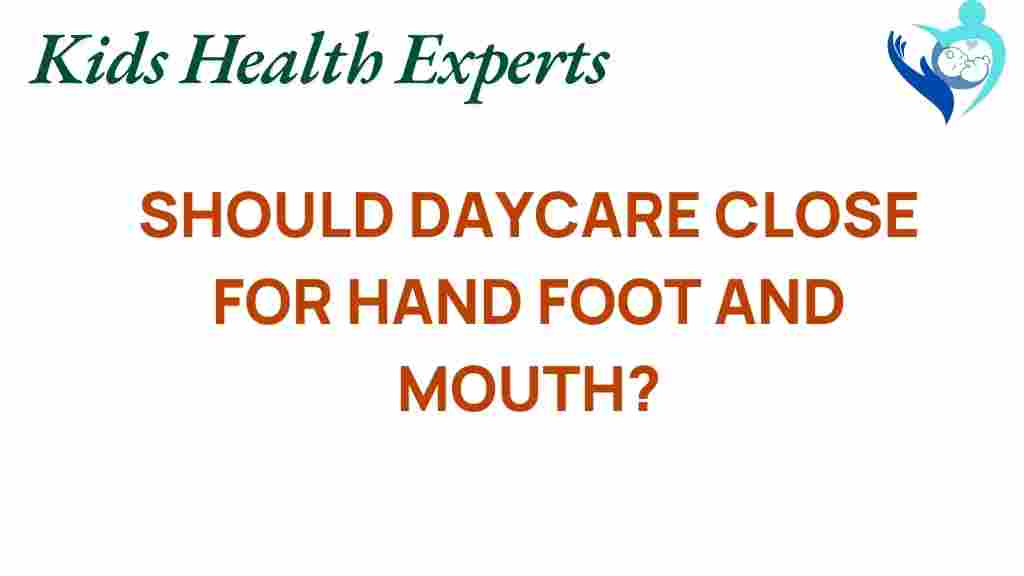Should Daycares Close for Hand, Foot and Mouth Disease?
Hand, Foot, and Mouth Disease (HFMD) is a common viral infection that primarily affects young children and is known for causing uncomfortable symptoms. As outbreaks of HFMD occur, many parents and daycare providers find themselves in a dilemma: should daycares close for hand, foot, and mouth disease? This article aims to unveil the controversy surrounding this issue, focusing on health protocols, child safety, and infection control.
Understanding Hand, Foot, and Mouth Disease
HFMD is typically caused by coxsackievirus and is most prevalent among children under five years old. Symptoms include:
- Fever
- Sore throat
- Painful sores in the mouth
- Rash on the hands and feet
- Loss of appetite
HFMD is highly contagious and spreads easily in daycare settings, making it a significant concern for parents and staff alike. Understanding the symptoms and transmission is crucial in determining whether a daycare should close during an outbreak.
The Risks of HFMD in Daycares
Daycares are environments where children are in close contact, increasing the risk of spreading infections. Here are some key points to consider:
- Close Proximity: Children play and interact closely, facilitating the rapid spread of HFMD.
- Hygiene Practices: Not all children maintain proper hygiene, making it easier for viruses to spread.
- Vulnerable Population: Many children in daycare may have weaker immune systems, making them more susceptible to infections.
Health Protocols for Daycares
To manage the risks associated with HFMD, daycares should implement strict health protocols. Here’s a step-by-step process for infection control:
1. Monitor Symptoms
Educators and caregivers should be trained to recognize the symptoms of HFMD. Regular checks can help identify affected children early.
2. Encourage Good Hygiene
Teaching children the importance of handwashing is essential. Daycares should:
- Provide handwashing stations with soap and water.
- Encourage children to wash hands before eating and after using the restroom.
- Use hand sanitizers when soap and water are not available.
3. Isolate Infected Children
Children showing symptoms of HFMD should be isolated from others until they are symptom-free for at least 24 hours. This helps prevent further spread within the daycare.
4. Clean and Disinfect
Regular cleaning and disinfecting of toys, surfaces, and common areas are critical. Use EPA-approved disinfectants effective against viruses. This should be done daily, especially during outbreaks.
5. Communicate with Parents
Keeping parents informed about the situation is vital. Daycares should:
- Notify parents of any reported cases of HFMD.
- Provide guidelines on symptoms and when to keep children at home.
- Encourage parents to maintain communication about their child’s health.
Should Daycares Close During an Outbreak?
The decision to close daycares during an HFMD outbreak is often controversial. Here are some considerations:
Arguments for Closing Daycares
- Safety First: Closing daycares can prevent the further spread of HFMD among children.
- Peace of Mind: Parents may feel more secure knowing their children are not in a potentially infected environment.
- Time for Cleaning: Closure allows staff to thoroughly clean and disinfect the facility.
Arguments Against Closing Daycares
- Disruption of Care: Many parents rely on daycares for childcare, and closures can create significant disruptions.
- Not Always Necessary: If proper health protocols are followed, daycares may be able to contain the outbreak without closure.
- Education Impact: Extended closures can hinder children’s learning and social development.
Child Safety and Infection Control
Ultimately, the safety of children should be the priority. Implementing robust infection control measures is essential to protect children while allowing daycares to remain open. Here are some strategies for ensuring child safety:
- Regular Health Screenings: Conduct daily health checks for symptoms of HFMD.
- Training Staff: Provide staff with training on recognizing symptoms and proper hygiene protocols.
- Parent Education: Educate parents on the importance of keeping sick children at home.
Troubleshooting Common Concerns
Even with the best protocols in place, questions and concerns may arise. Here are some common issues and solutions:
Concern: My Child Has HFMD, But The Daycare Is Still Open
If your child has been diagnosed with HFMD, it is crucial to keep them at home until they are symptom-free. Communicate with the daycare to ensure they are following proper protocols.
Concern: What If Other Children Are Not Being Isolated?
If you notice that other infected children are not being isolated, raise the issue with the daycare management. They should be following health protocols to protect all children.
Concern: How Can I Protect My Child from HFMD?
Encourage your child to wash their hands regularly, avoid sharing food or drinks, and maintain personal space as much as possible in crowded settings.
Conclusion
The question of whether daycares should close for hand, foot, and mouth disease is complex. While the health and safety of children must always come first, the impact of closures on families and children’s development cannot be overlooked. It is crucial for daycares to implement robust health protocols, maintain open communication with parents, and stay informed about infection control measures to manage outbreaks effectively. By prioritizing child safety and adhering to health protocols, daycares can minimize the risks associated with HFMD while continuing to provide essential childcare services.
For more information on child health and safety, visit this resource. If you want to read more about infection control in daycares, check out this article.
This article is in the category Conditions and created by KidsHealthExperts Team
